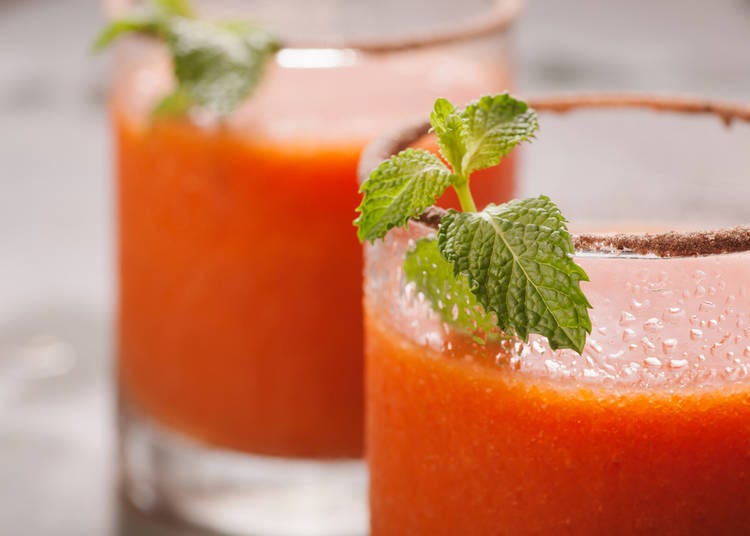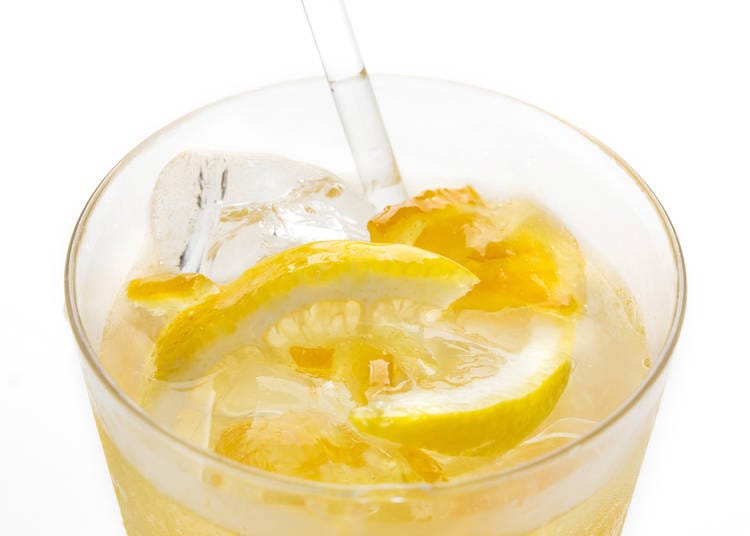
Japanese alcohol comes in a variety of types, many of which you might not find outside the country! You might just think of Japanese whiskey and sake, but actually there is so much more to discover.
Here we'll introduce ten major types to try when visiting Japan!
1. Atsukan

Atsukan, especially popular in the colder months, is piping hot Japanese sake or rice wine. Sake is made from rice, koji mold, yeast, and water.
Atsukan has a somewhat smooth and acidic taste. Atsukan technically means “hot sake,” but there are actually many different temperature levels you can indulge. The general term for hot sake is okan or kanzake. Whatever temperature you prefer, hot sake should definitely be on your list of drinks to try in Japan.
- Tobikiri
- 55°C / 131°F
- Atsukan
- 50°C / 120°F
- Joukan
- 45°C / 113°F
- Nurukan
- 40°C / 104°F
- Hitohadakan
- 35°C / 95°F
- Hinatakan
- 30°C / 86°F
- Hiyakan
- 15-25°C / 59-77°F
- Suzu-bie
- 15°C / 59°F
- Hanabie
- 10°C / 50°F
- Yukibie
- 5°C / 41°F
2. Awamori

Awamori is a distilled type of Japanese alcohol local to Okinawa that is usually consumed either with water, ice, or mixed. The water, yeast, and rice in awamori comes from Thailand, while the black koji mold used to create it is local to Okinawa. Awamori that has aged more than 3 years is called kuusu.
Kuusu can have a relatively rich yet mellow taste compared to awamori, which has a stronger but smoother flavor compared to sake. Awamori is somewhat analogous to whiskey, and kuusu to single-malt scotch. Both awamori and kuusu can be enjoyed with ice, water, mixed, or even by themselves.
3. Japanese Beer

When asked for drink orders, Japanese often exclaim “toriaezu biru” without even looking at the menu. This basically means, “Let's start off with beer,” and not only is it an easy way to start the drinks off without taking too much time, it shows just how popular beer is in Japan. If you need a go-to drink in Japan, beer is a recommended starter especially if you are at an izakaya where it's popular to use this phrase.
You can order nama biru, which is a draught (or draft) beer, or bin biru which is a large, oftentimes half-liter bottle of beer to be shared among people at the table. It is actually quite common to simply order “draft beer” without specifying the type. This is because at most establishments, not only is there only one type of beer on tap, the majority of Japanese people don’t care to trouble themselves with the choice.
Like most everywhere else in the world, beer is an alcohol made from cereal grains, yeast, hops, and water. In recent years, however, there has been somewhat of a craft beer movement and bars selling several different types of beers including a variety of craft beers available on tap are popping up more and more.
Beer was first introduced to Japan by Dutch merchants at Dejima, which was an island trading post from the time when Japan was more isolated. The country soon started importing beers after reopening to the outside world, and later Japanese started making their own. Today you can order beer at most bars and many restaurants. There is non-alcoholic beer available, as well as happoshu which is a low malt almost beer that exists as a cheaper alternative to real beer. Next time you find yourself in a drinking establishment in Japan, try using out the phrase toriaezu biru!
4. Lemon Sour

Especially popular with younger women or those who prefer something relatively mild is a lemon sour, also called lemon chu-hai.
This drink is made from club soda, shochu, and lemon—in fact, you may even be given a whole lemon to squeeze out into your jug! This drink can be found in different varieties, such as yuzu, grapefruit, sudachi, and shikuwasa, and lemon sour was invented in Tokyo.
Some izakaya or other eating establishments may serve chu-hai pre-mixed, and you can find it canned as well. Being a fruity drink, this drink is quite sweet so it’s perfect for those with a sweet tooth.
5. Oolong Hai

Oolong hai, or oolongcha hai, is another drink that’s made with shochu. Put simply it is oolong tea mixed with either mugi shochu. Though it’s possible to mix imo shochu with the oolong tea, it tends to be a bit strong of a taste to mix well with oolong tea. Oolong hai can have a noticeably strong tea flavor that can somewhat overpower the taste of mild shochu so if you’re a tea-lover, oolong hai may be the drink for you.
6. Red Eye Cocktail

While the red-eye cocktail can often be made with a combination of beer, tomato juice, and optionally lemon juice, other versions can call for a raw egg and vodka to be added. A canned version in Japan is essentially happoshu with tomato juice. You can drink the canned version by itself cold in a glass.
7. Shochu

Shochu is what people would generally expect an older “gentleman” to be drinking so if you’re caught ordering shochu at your next nomikai, your comrades are likely to say you look shibui (refined).
First made in the 1500s in Kyushu, it is a distilled Japanese alcohol which is created starting with a fermented mash of water, yeast, and koji mold. Next, the crushed base ingredient is added to the mash and left to ferment. After this, the mixture is distilled.
Base ingredients can include mugi (barley), imo (sweet potato), rice, sugarcane, buckwheat, or shiso which is a leaf from the mint family. Mugi shochu has a mild flavor and is good for beginners, while imojochu (sweet potato shochu) has a stronger flavor and can be consumed warm. Try buckwheat shochu for a mild but slightly bitter taste, or go slightly sweet with sugar cane shochu. Not unlike shiso itself, shiso shochu has a soft and slightly herbal flavor.
Shochu is commonly consumed by itself, with ice, mixed with other drinks, warmed, or with water added. Mizuwari is alcohol mixed with water, and oyuwari is the warmed version of mizuwari. If you’re drinking expensive shochu, you should definitely drink it on the rocks first to fully enjoy the aroma and flavor.
8. Umeshu

Umeshu, a unique type of Japanese alcohol, is a kind of plum wine using a specific kind of tart plum, alcohol such as shochu or sake, and a sweetener like sugar.
Whether by itself, with ice, mixed with other drinks, or with warm or cold water, umeshu has a sweet and smooth taste that some might call “dangerous” because it goes down so easily.
If mixing is your thing, you may want to try it with one of the fruit and vegetable juice blends found in supermarkets. Of course, plenty of restaurants also serve their own umeshu varieties.
9. Whiskey Highball

Whiskey highball, a popular alcohol in Japan is a combination of whiskey and sparkling (carbonated) water that is quite popular in izakayas and restaurants and can even be found canned in most convenience stores or supermarkets. If you drink it in a glass it's recommended to do so on the rocks.
As tasty as this drink is, whiskey highball can be enhanced even more with carbonated soda or fruit varieties as well. Just one taste will tell you why it’s now considered one of the most popular drinks in Japan.
10. Yuzushu

Yuzushu, similar to limoncello, has similar ingredients to umeshu—except that yuzu, a citrus fruit, is used instead of sour plum.
The taste is like tangy lemonade with alcohol but made with a different somewhat lemon reminiscent citrus fruit. This can be consumed by itself, with ice, mixed with other drinks, or with water added cold or warm. If you’ve tried and liked umeshu then chances are you’ll like Yuzushu as well.
Japanese alcohol runs the gamut from fun and fizzy cocktails to deep fermented wines, beer and everything in between. Whether you’re looking to fuel a fun night or need a perfect pick-me-up during an after-hours business gathering, you can rest assured that these popular Japanese drinks all fit the bill!
Japanese Alcohol from Beer to Yuzushu and More
Now a quick word on Japanese drinking culture. It’s not uncommon for companies to have practically obligatory nomikai (drinking parties) several times a month.
Though most nomikai will take place at an izakaya (a drinking establishment with drinking food), there are plenty of other places people love to gather for a drink such as tachinomi (small standing bars), shot bars, pubs, kyabakura (“cabaret club”, a kind of hostess club) and dining bars.
At most restaurants or izakayas, you can even choose to do a nomihodai (all you can drink). From straight-up beer to Okinawan rice wine and hot sake, here are 10 popular types of Japanese alcohol for every situation.
Related Articles
*Prices and options mentioned are subject to change.
*Unless stated otherwise, all prices include tax.
Recommended places for you
-
Appealing

Sapporo Ramen Yokocho
Ramen
Sapporo / Chitose
-

Sapporo Clock Tower
Landmarks
Sapporo / Chitose
-

Former Hokkaido Government Office Building (Red Brick Office)
Other Historic Sites
Sapporo / Chitose
-
Appealing

Rukku and Uohei
Izakaya
Sapporo / Chitose
-
Appealing

Kanemori Red Brick Warehouse
Shopping Malls
Hakodate
-
Appealing

Mt. Hakodate Observatory
Forests & Mountains
Hakodate
-

Enjoy Scenic Views and Outdoor Activities in Northern Japan! Top things to do in Onuma Quasi-National Park
-

Beyond Hakodate and Matsumae: Enjoy the Hidden Gems of Hokkaido’s Donan Area
-

A Tour of Niseko Distillery: Exploring the World of Japanese Whiskey and Craft Gin
-

Scenic Road Trip from Hakodate to Matsumae: Stunning Views, Traditions, and Tasty Delights
by: Nobuka Kawashima
-

Enjoy Breathtaking Hot Air Balloon Flights in Niseko! Gorgeous View of Nature from the Sky
-

Don’t Miss These 5 Popular Local Hokkaido Chain Restaurants - For Onigiri, Curry & More
by: Nobuka Kawashima
-

Buffets & More: 5 Best Sapporo Seafood Restaurants for the Finest Fresh Fish
-

Enjoying Hokkaido Shrine in 2025: Traveler's Guide to Rituals, Souvenirs, and Food
-

Hokkaido's Renovated Cloud-Viewing 'Unkai Terrace' Brings You To The Sky's Edge, Has 'Cloud Cafe'
-

Hakodate 2-Day Itinerary for Exploring Japan's Foodie North!
-

12 Fun Things to Do Near Otaru Canal: Art, History & More
-

Secrets to Shopping in Japan: Guide to Annual Sales in Japan & Where to Shop
by: Miyu Shimada
- #best sushi hokkaido
- #things to do hokkaido
- #best ramen sapporo
- #what to bring to japan
- #new years in tokyo
- #what to buy in ameyoko
- #japanese nail trends
- #what to do in odaiba
- #onsen tattoo friendly tokyo
- #daiso
- #best sweets otaru
- #japanese fashion culture
- #best nature furano
- #japanese convenience store snacks
- #best japanese soft drinks


















